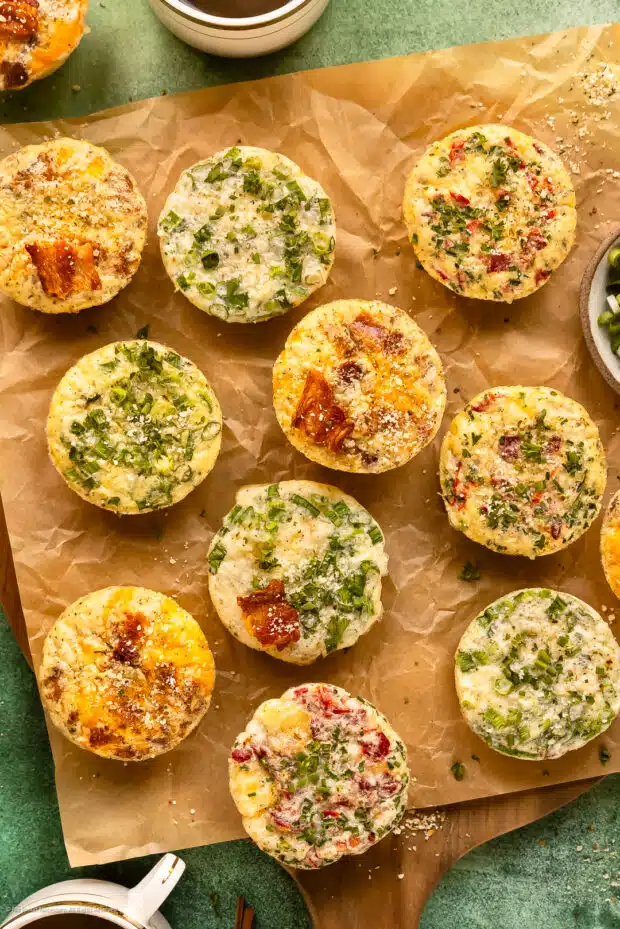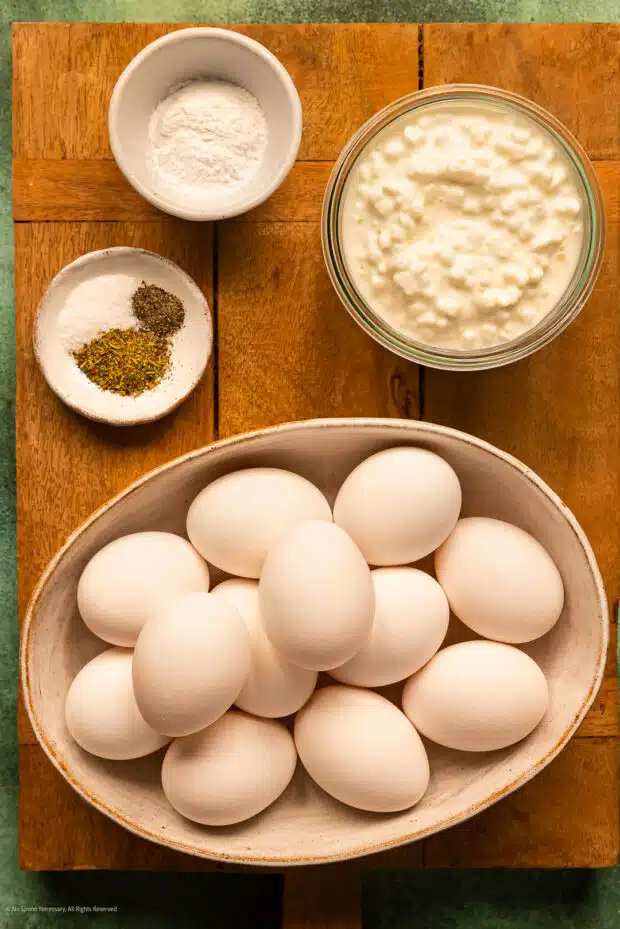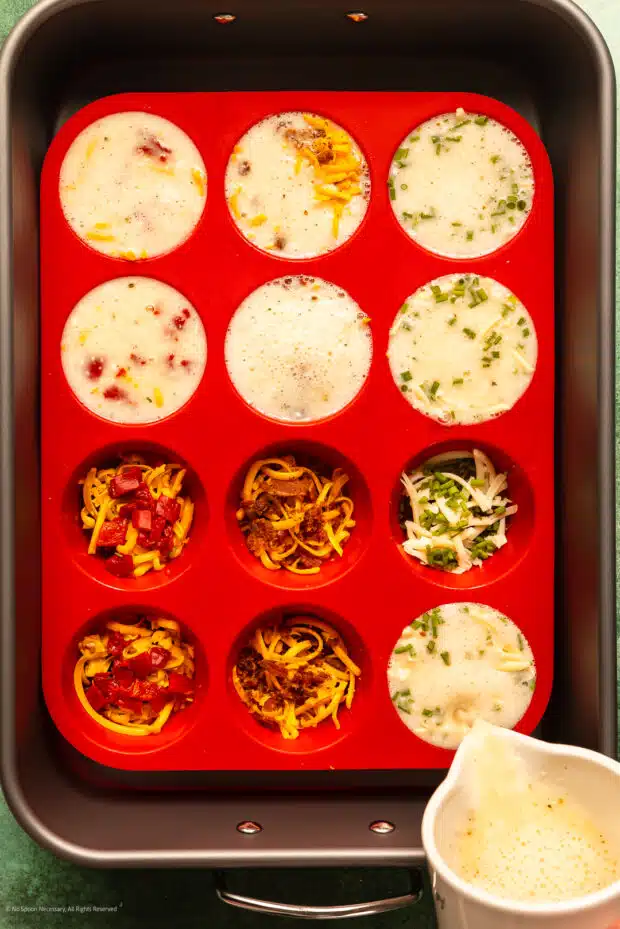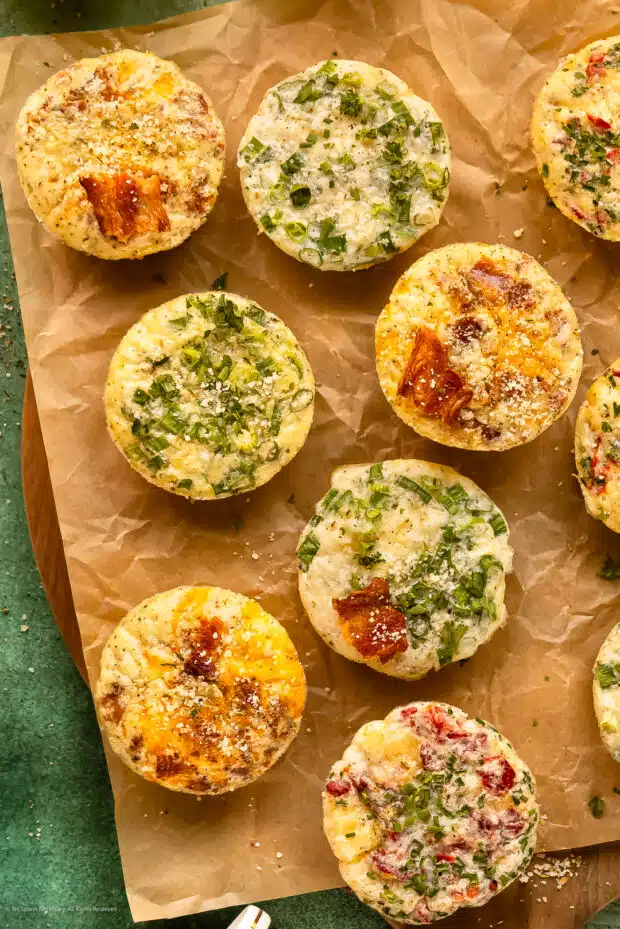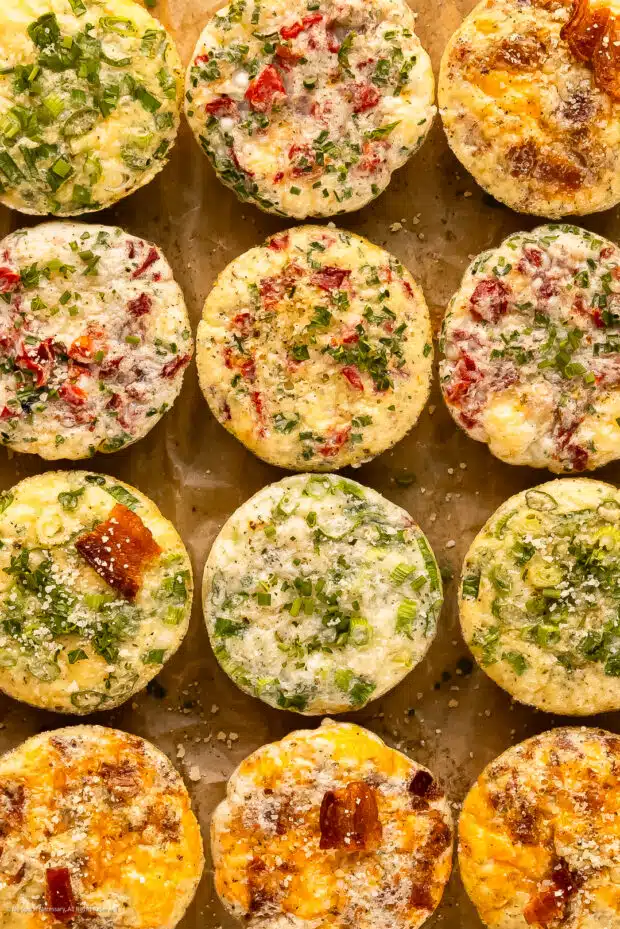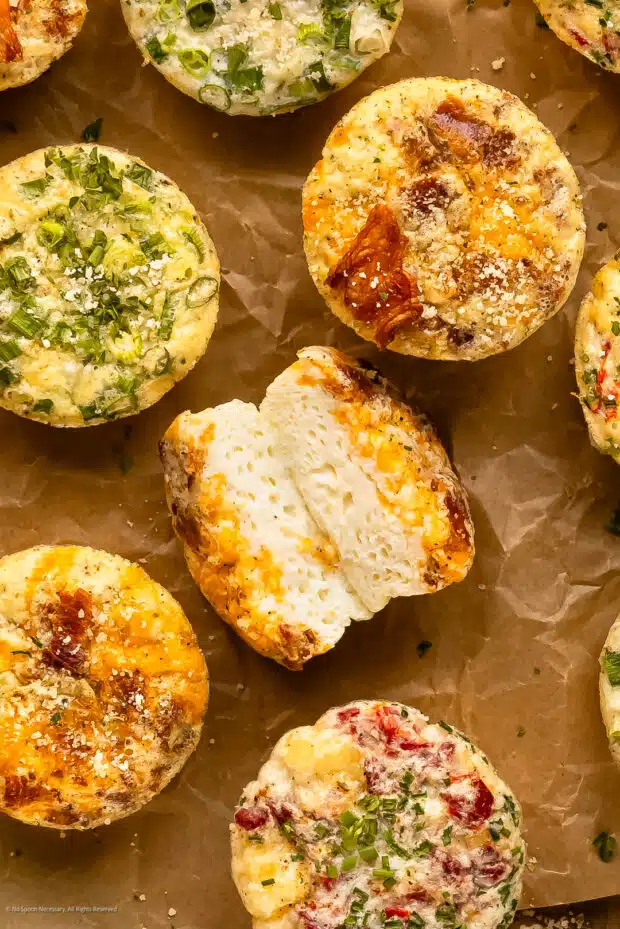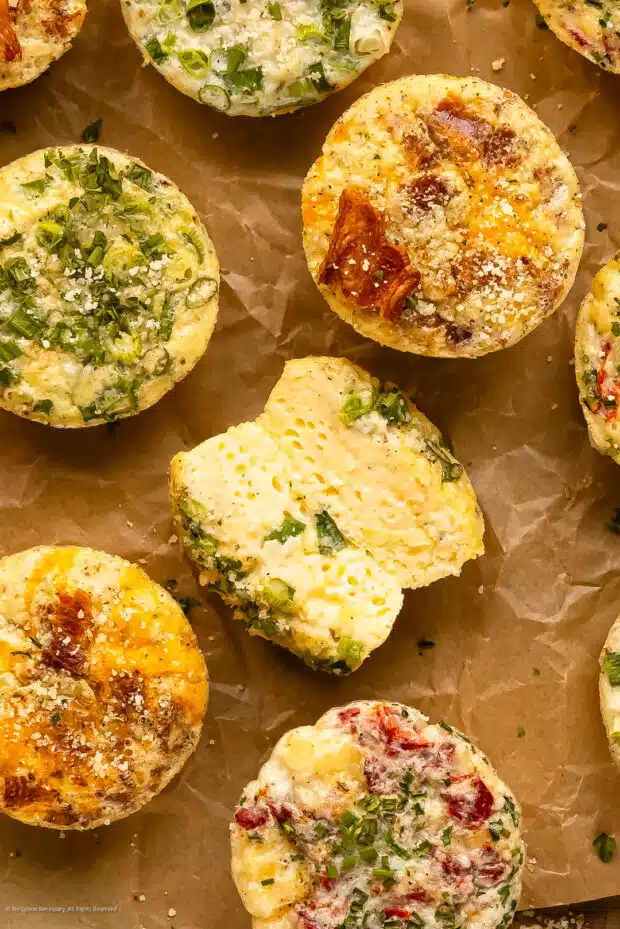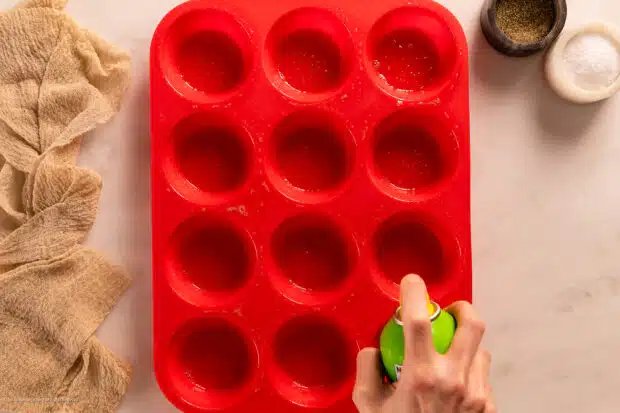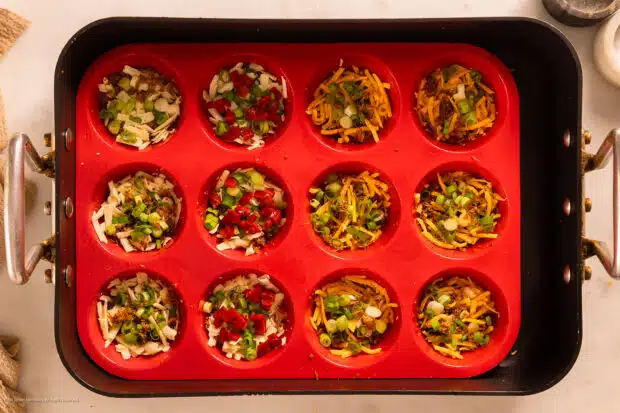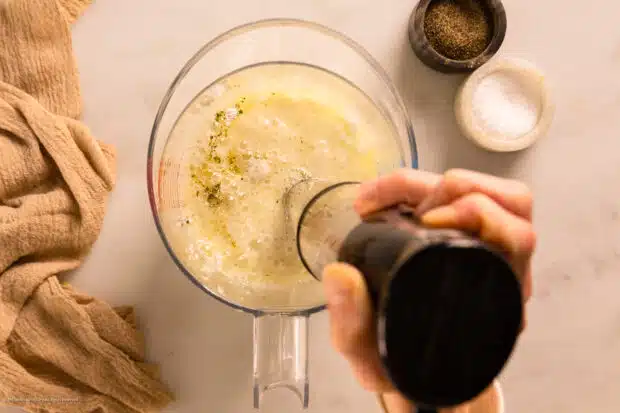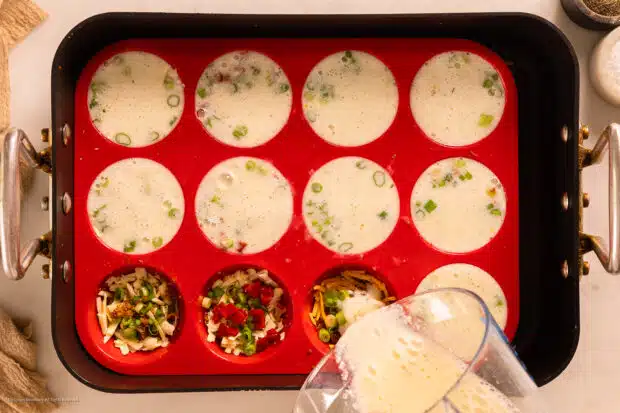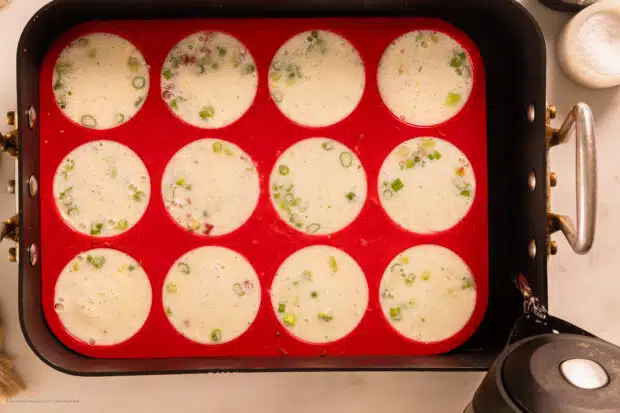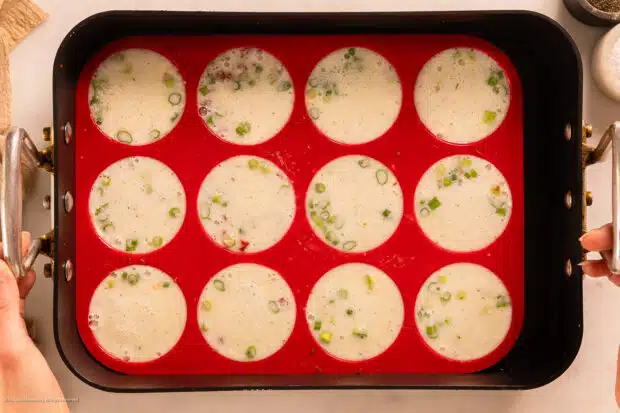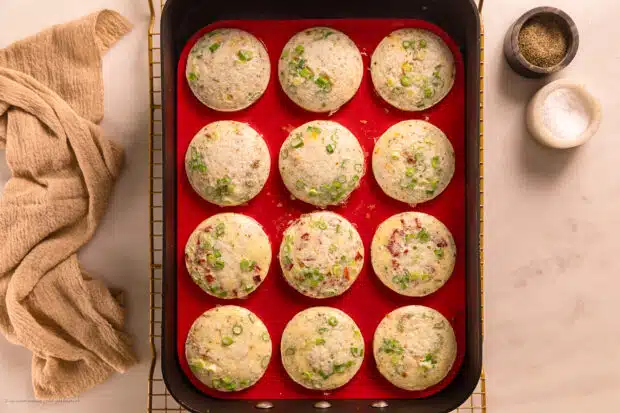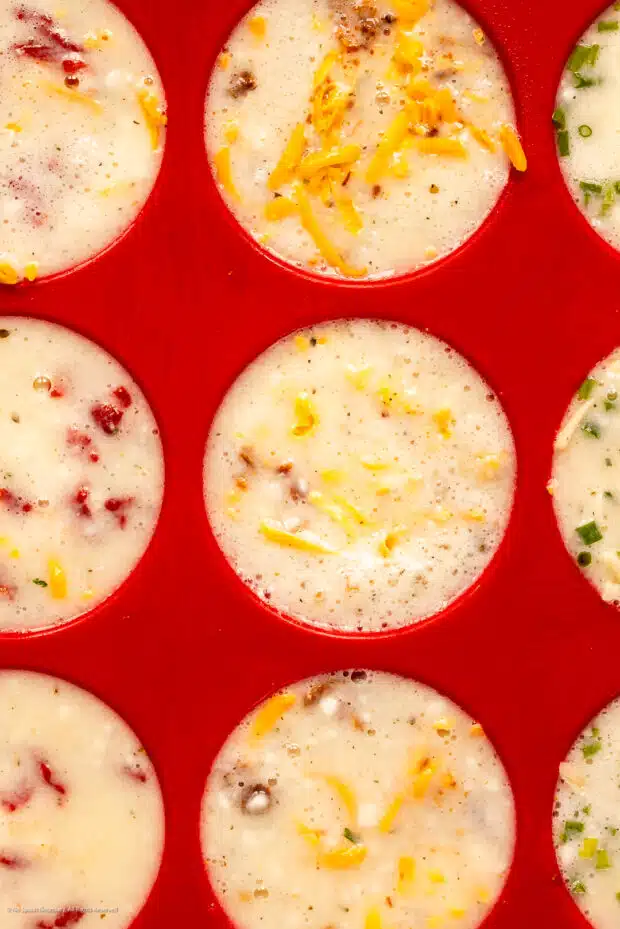This post may include affiliate links. Thank you for your support.
Breakfast Egg Muffins are the perfect easy, grab-and-go breakfast! Loosely inspired by the popular Starbuck’s egg bites, these egg muffins have a fluffy, velvety texture and endless customizable filling options, like bacon, bell peppers, spinach, and more! Packed with flavor and protein, an egg breakfast muffin is the ideal way to start your day. (Vegetarian option, plus they store great in the fridge and freezer for meal preps!)
Table of Contents
About this egg breakfast muffin recipe
If you’ve been on the hunt for a delicious and easy breakfast recipe to meal prep, you’ve found it. My family has been eating these egg muffins for breakfast nearly every morning since the as long as I can remember, and we’re still going strong. I even make them for holiday brunches, because they’re super easy and always a hit. I mean, they’re essentially like mini frittatas, so what’s not to like?! But, here’s why you’re gonna love ‘em:
- They Never Get Boring. These low-carb muffin breakfast eggs are every bit as customizable as an omelet at a diner. And since you simply add your preferred fillings to the muffin pan and pour the egg mixture on top, you can make as many different varieties as you like in every batch of a dozen.
- Mornings Have Never Been Easier. You can pop an egg breakfast muffin in the microwave and have a hot, hearty meal ready to chow down in less than 5 minutes. Oh, and for all my commuters out there, you’ll appreciate that they’re easy to eat in the car.
- Prepping Them Takes Just 10 Minutes, then the oven does all the work. At most, you’ll only need to spend about 30 minutes in the kitchen. Do yourself a favor and save the recipe for these eggy breakfast muffins. The whole family is sure to love them!
- They’re GOOD For You! High-protein, low-carb, and naturally gluten-free, these little babies are the real deal. Plus, they taste amazing!
If you’re looking for more hand-held, grab-and-go breakfasts, try this recipe next: Bagel with eggs and cheese
Ingredients for egg muffin breakfast
While this breakfast egg muffins recipe is endlessly adaptable depending on what mix-ins you choose to add, you need just 6 ingredients to make the base recipe. Here’s what to grab:
- Olive Oil, Butter, or Non-Stick Cooking Spray – It’s just for greasing the muffin tin, so take your pick. Bacon fat also works!
- Egg Whites or Whole Eggs – Right off the bat, you get to make a choice. Egg whites are lower fat, but unless you use the kind in a carton, they come with extra prepping. Either way, make sure to read the optional variations section below for how to tweak the egg muffins recipe depending on your choice.
- Cottage Cheese – For a light, fluffy texture and added protein. You can swap in block-style cream cheese if you prefer, just make sure it’s at room temperature. Also, note that there will be more fat and less protein per egg muffin if you make this swap.
- Tapioca Flour – This gluten-free binding and thickening agent also goes by “tapioca starch.”
- Italian Seasoning – One bottle holds at least 5 different spices, meaning lots of flavor with very little effort.
- Salt & Freshly Ground Black Pepper – For seasoning, to taste.
- Fillings of Choice – Here’s where all the fun is. Mix and match any of the items below to create personalized breakfast muffin eggs that’ll get you excited to get out of bed in the morning:
- Veggies: Fresh baby spinach, asparagus, zucchini, roasted red bell peppers, red onions, mushrooms, grape tomatoes or cherry tomatoes
- Meats: Crispy bacon bits, cooked breakfast sausage, Canadian ham, or cold cut deli meats
- Herbs: Scallions and parsley
- Cheese: Try freshly shredded Gouda, mozzarella, or cheddar for a melty vibe. Crumbled feta cheese for salty, briny pops, or freshly grated Parmesan for a mix of the two.
Recipe variations
This morning egg muffin recipe is very easy to customize. Let’s start with the first choice you’ll need to make:
- If you want to use egg whites for a lighter breakfast, use 1 ½ tablespoons of tapioca flour. If using whole eggs (or whole eggs + egg whites as described below), reduce the tapioca flour to a scant tablespoon.
- If you want to use whole eggs, (versus egg whites), I recommend adding a few more egg whites for the best results. WHY? An egg white is made up of 90% water, while the yolk is made up of 50% water. The extra moisture in the whites lends a more velvety, moist texture to the egg muffins. While you CAN use just whole eggs in this recipe, I’ve found they turn out best when you use about 2/3 whole eggs and 1/3 egg whites.
Flavor variations
Next stop, Flavor Town! There are nearly infinite ways to mix and match your add-ins for these muffin pan eggs, which can feel overwhelming. If you’re not sure where to start, here are some predictably delicious options:
- Lux Meat Lover’s Dream – My hubby loves a combo of bacon, Canadian ham or leftover glazed ham, and gouda.
- The Cheyanne Special – My favorite is roasted red bell peppers, bacon, scallions, white cheddar cheese, and a touch of hot sauce. Don’t forget to garnish them with a small piece of candy bacon stuck on top!
- Denver – Canadian bacon, roasted green bell pepper & onions, and sharp cheddar.
- Mediterranean – Sun-dried tomatoes, spinach, & feta.
- Florentine – Sautéed spinach with garlic and onions (make sure to drain it after cooking!) with goat cheese or provolone.
- California – Sautéed mushrooms and green peppers, scallions, & white cheddar. Don’t forget to serve with some fresh avocado slice.
- Veggie Heaven – Sauté all your favorite vegetables and throw them in your egg muffins.
How to make breakfast egg muffins
This egg muffin breakfast is super easy to prepare. Here’s how:
- Preheat Oven and Prep Pans: Preheat your oven to 325-degrees Fahrenheit. Grease a standard 12-count silicone muffin pan with oil, butter, or nonstick cooking spray and then place the prepared silicone muffin pan inside a casserole dish, baking pan, or roasting pan large enough to hold the silicone molds. Bring 4 cups of water to a boil using a microwave, electric kettle, or stove top.
- Add Fillings to Muffin Tins: Divide the filling evenly among the muffin tins, filling each cavity with about 2 heaping tablespoons of filling; then set aside.
- Blend Eggs, Cottage Cheese, and Flour: In a blender or a large 5+ cup measure, add the eggs, cottage cheese, tapioca flour, Italian seasoning, ½ teaspoon salt, and ¼ teaspoon pepper. Cover the blender with the lid or use an immersion blender to blend the eggs on HIGH speed until the mixture is just creamy and combined. (Tip: While you want the egg mixture to be creamy and frothy, you do NOT want to over-blend the mixture. Stop blending when the eggs are frothy.)
- Fill with Egg Mixture: Carefully and evenly fill the muffin tins all the way up with the egg white mixture or egg mixture. Optional – Use the tins of a fork or a chopstick to gently stir the ingredients in each egg cup.
- Add Boiling Water Bath to Pan: Pour the boiling water into the large pan, adding enough water to fill halfway up the sides of the muffin cups.
- Bake in Preheated Oven: Transfer baking pan filled with water and egg muffins into the 325-degree oven. Bake for 25-30 minutes, or until the eggs are just set.
- Cool Slightly, Then Remove Breakfast Eggs from Muffins Molds: Transfer the egg muffins from the oven to a wire rack and let the eggs cool in the muffin tins for 3-5 minutes. Once the breakfast egg muffins are cool enough to handle, remove them from the molds and transfer to a serving plate.
- Serve: Serve breakfast muffin eggs warm with your favorite breakfast toppings and sauces.
Expert tips for the best egg muffins for breakfast
- Invest in a silicone muffin tin. It makes popping out these muffin pan eggs SO MUCH EASIER than with a traditional metal pan. Alternatively, you can use reusable silicone muffin cups, but those are usually ridged, which means more sticking. Plus, they’re a bit more unwieldy than a full pan.
- Put the muffin pan on a sheet pan before adding the fillings and egg mixture. This will keep the soft silicone from dipping in the middle and making a mess when you try to put it in the oven.
- For more variety, make 3 or 4 of a single flavor using the rows or columns of the muffin tin to help you remember which is which. Label your storage containers so you can eat something new every morning!
FAQs: frequently asked questions
Why are my egg muffins spongy?
Uh-oh! Sounds like one of a few things could’ve happened:
- You went a little too crazy on the add-ins. Make sure you keep to no more than 1 ⅔ cup of extras, or there won’t be enough eggs to hold it together. When this happens, the egg texture can get a little wonky.
- There’s too much liquid. You’ll want to cook veggies before adding them and drain off any excess liquid. By the same token, drain any fatty items like bacon on paper towels before adding them.
- You used something other than tapioca flour as your binder and the ratio was off. You need a certain amount of starchy assistance to help keep your eggs in a muffin tray together. However, not all binders are created equally and need to be applied in different ratios. Tapioca has roughly 3x the binding power of AP flour (so you’d need ¼ cup + 1 Tablespoon of flour if you use all egg whites) and ½ the power of cornstarch (so you’d need 3⁄4 of a tablespoon cornstarch if you use all egg whites).
- You used ALL whole eggs rather than supplementing with whites. As I mentioned earlier in the article, egg whites have more water than egg yolks. While you don’t want to add too much liquid, a little bit is important to getting the proper velvety texture we’re after. Use a ratio of 2 parts whole eggs to 1 part whites for the best results.
Why are my egg muffins watery?
Again, there could be several culprits here:
- Too much liquid, not enough binder. It’s all about proportions. For egg whites, use 1 ½ tablespoons of tapioca flour, as they have more water content than egg yolks. For whole eggs + egg whites, the recipe indicates you should reduce the tapioca flour to a scant tablespoon.
- Underbaking. If the top of your breakfast egg muffin looks loose, they need a bit more time in the oven to finish cooking.
- You didn’t cook your veggies, or you added too many. These muffin pan eggs need a little bit of moisture to get a smooth, creamy texture, but too much and you’re in trouble. If you’re going veggie heavy, make sure to cook and drain them first, then measure to make sure you’re not using too much.
Why are my egg muffins rubbery?
Typically speaking, muffin cup eggs get rubbery when they’re overcooked. Make sure to pull them from the oven before they get too brown, and be gentle when you reheat them.
Why do my egg muffins fall? How do you keep them from sinking in the middle?
By scrambling the eggs, you introduce air which acts as a leavener, helping the eggs rise. (This is also why we cream butter and sugar in so many recipes.) The eggs themselves aren’t strong enough to hold the shape once that air puffs it up; as the muffin cools, the eggs collapse in on themselves. By adding stability via starch and cottage cheese, these muffin tin eggs shouldn’t fall. Just follow the recipe!
Are breakfast egg muffins healthy?
I suppose that all depends on what your version of healthy is. What I will say is that the base recipe for these eggs in a muffin pan is high in protein, relatively low fat, and low-carb. The add-ins you choose will determine where you go from there. For example, a veggie-forward blend of mix-ins will probably have less fat and lower sodium than one with bacon, sausage, and ham.
Serving baked muffin tin eggs
Here are some heartwarming serving suggestions that will make your mornings a tad brighter and a whole lot tastier:
- Family-Style Breakfast: Imagine a colorful spread that brings everyone to the table, smiling and ready to dive in. Arrange multiple flavors of your beautiful egg muffins alongside vibrant macerated fruit slices, crispy bacon, and a skillet of home fries and onions. Perfect for those precious lazy weekends with your fam.
- On-the-Go Goodness: I know how hectic mornings can be, especially when there’s a commute involved. Why not wrap an egg muffin in a napkin, grab a banana, and head out the door? It’s a fuss-free, easy to eat on the run, and nutritious breakfast that will keep you fueled and ready to conquer the day.
- Brunch with Friends: Who doesn’t love brunch? Next time you’re hosting, let your egg muffin cups be the star of the show. Pair them with a fresh salad, some sweet cheese danishes or the best cinnamon toast, and, of course, a sparkling mimosa bar replete with several flavors of pureed fruit juices. Unlike that fancy brunch spot, you get to pick the music and nobody is gonna kick you out to turn a table. WINNING.
- Me Time Mornings: For those serene first moments of the day (sometimes before dawn even breaks), when I actually have time to sit and breathe before all the to-dos start to wash over me, I like to grab an egg muffin for breakfast with a warm cup of coffee for me. But, don’t forget the hot chocolate cocoa or white chocolate cocoa for littler ones!
- Hand-Held Brunch: If you’re having people over, consider throwing a “little-bites, big-flavors” brunch party with all your hand-held favorites. Think: egg muffins, cinnamon sugar donut holes, powdered sugar donut holes, paper muffin cups filled with toasted nuts or spiced nuts, and a bloody mary bar.
Storing muffin pan eggs
- Fridge Storage: Let leftover morning egg muffins cool completely to room temperature before storing in an airtight container in the fridge for 3-5 days.
- Freeze: Allow leftover egg white muffins and egg muffins to cool completely to room temperature before storing in an airtight, freezer-safe container in the freezer for up to 1-2 months. Defrost the egg cups in the fridge overnight before reheating according to the instructions below.
- Reheating: You can simply enjoy breakfast egg muffins cold from the fridge if you like. However, I like to at least let them sit out on the counter at room temp for 20 minutes to remove the unpleasant chill. To further warm them, you have 2 options:
- Microwave: Wrap the egg bite in a damp paper towel and microwave in short 30 second bursts until warm throughout.
- Steamer: Gentle steaming will produce the best results for reheating egg muffin cups. Place small amount of water in a saucepan, insert a steamer basket, and place over medium heat. Bring water to a simmer, add egg bites to the steamer basket, cover the pot, and steam the egg bites until they’re warm throughout, about 5 minutes.
Whether you’re a whisk-taker in the kitchen or just someone looking to add a little more egg-citement to your mornings, I hope these Egg Breakfast Muffins crack open a whole new world of delicious possibilities for you. Remember, life’s too short for bland breakfasts, so let’s make every bite count and every morning a little more egg-straordinary — together.
Craving MORE? Follow all the deliciousness on Facebook, Pinterest and Instagram!
More baked muffin tin eggs!
Best muffin breakfast eggs👇

Egg Muffin Breakfast
Equipment
- 1 High Powered Blender OR Immersion Blender with Large Liquid Measure (for blending eggs)
- 1 Silicone Muffin Pan (for making egg breakfast muffins0
- 1 Large Casserole Pan OR Roasting Pan (large enough to hold the muffin pan)
Ingredients
- As Needed Olive Oil - Butter, or Non-Stick Cooking Spray (for greasing muffin tins)
- 2 ½ Cups Egg White OR 10 Large Eggs (SEE NOTES)
- 1 Cup Cottage Cheese (I use low fat)
- 1 ½ TBS Tapioca Flour (SEE NOTES)
- ½ tsp Italian Seasoning
- To Taste Kosher Salt and Ground Black Pepper
- 1 ½ to 1 2/3 Cup Filling Options (SEE NOTES)
Instructions
- Preheat Oven and Prep Pans: Preheat your oven to 325-degrees Fahrenheit. Grease a standard 12-count silicone muffin pan with oil, butter, or nonstick cooking spray and then place the prepared silicone muffin pan inside a casserole dish, baking pan, or roasting pan large enough to hold the silicone molds. Bring 4 cups of water to a boil using a microwave, electric kettle, or stove top.
- Add Fillings to Muffin Tins: Divide the filling evenly among the muffin tins, filling each cavity with about 2 heaping tablespoons of filling; then set aside.
- Blend Eggs, Cottage Cheese, and Flour: In a blender or a large 5+ cup measure (you’ll need an immersion blender), add the eggs, cottage cheese, tapioca flour, Italian seasoning, ½ teaspoon salt, and ¼ teaspoon pepper. Cover the blender with the lid or use an immersion blender to blend the eggs on HIGH speed until the mixture is just creamy and combined. (Tip: While you want the egg mixture to be creamy and frothy, you do NOT want to over-blend the mixture. Stop blending when the eggs are frothy.)
- Fill Muffin Tins with Egg Mixture: Carefully and evenly fill the muffin tins all the way up with the egg white mixture or egg mixture. Optional - Use the tins of a fork or a chopstick to gently stir the ingredients in each egg cup.
- Add Boiling Water Bath to Pan: Pour the boiling water into the large pan, adding enough water to fill almost halfway up the sides of the muffin cups. (Tip: Don't add too much water or you will have a hard time moving the pan into the oven!)
- Bake Egg Muffins in Preheated Oven: Transfer baking pan filled with water and egg muffins into the 325-degree oven. Bake for 25-30 minutes, or until the eggs are just set.
- Cool Slightly, Then Remove Egg Muffins from Mold: Transfer the muffin tin of egg bites from the oven to a wire rack. Let the egg bites cool in the muffin tins for 3-5 minutes. While cooling, loosen the egg bites from the sides of the muffin pan using a thin knife. After 5 minutes and once the breakfast egg muffins are cool enough to handle, remove the egg bites from the molds and transfer to a serving plate.
- Serve: Serve breakfast egg muffins warm with hot sauce, ketchup, or your favorite breakfast toppings and sauces. Enjoy immediately!
Notes
- Eggs: If you are using whole eggs (versus just egg whites), I recommend using slightly more egg whites than yolks for the best results. WHY? An egg white is made up of 90% water, while the yolk is made up of 50% water. The extra moisture in the egg whites lend more velvety, moist texture to the egg muffins. While you CAN use just whole eggs in this recipe, I’ve found the egg muffins turn out best when you use about 2/3 whole eggs and 1/3 egg whites. Or simply use all egg whites.
- Tapioca Flour: If using egg whites only, use 1 ½ tablespoons of tapioca flour. If using whole eggs or whole eggs and egg whites, reduce the tapioca flour to a scant tablespoon.
- Cheese: You can use cottage cheese or block-style cream cheese in this breakfast egg muffin recipe. If you are using cream cheese, make sure it’s at room temperature.
- Customize It: This recipe is very easy to customize. Use egg whites or whole eggs. Make it a lux meat lover’s dream by using bacon, Canadian ham, and gouda. Or try it my favorite way, with roasted red bell peppers, bacon, scallions, white cheddar cheese, and a touch of hot sauce. Don’t forget to garnish them by sticking a small piece of candy bacon in the top!
- Filling Options:
- Fresh Baby Spinach – roughly chopped
- Crispy Cooked Bacon – crumbled or chopped (1/4 cup of bacon is 4 slices)
- Cooked Breakfast Sausage – chopped or crumbled
- Canadian Ham or Cold Cut Deli Meats - Chopped
- Roasted Red Bell Pepper – patted completely dry and chopped
- Green Onions – thinly sliced
- Brown or White Mushrooms – cleaned and thinly sliced or chopped
- Grape or Cherry Tomatoes - halved
- Freshly Shredded Cheeses: Gouda, Mozzarella, Cheddar
- Crumbled Feta
- Grated Parmesan
- Fridge Storage: Allow leftover muffin eggs to cool completely to room temperature before storing in an airtight container in the fridge for 3-5 days.
- Freezer Storage: Allow leftover egg white muffins and egg muffins to cool completely to room temperature before storing in an airtight, freezer-safe container in the freezer for up to 1-2 months. Defrost the egg muffin cups in the fridge overnight before reheating according to the instructions below.
- Reheating: You can simply enjoy breakfast egg muffins cold from the fridge if you like. However, I like to at least let them sit out on the counter at room temp for 20 minutes to remove the unpleasant chill.
- Microwave: Wrap the egg bite in a damp paper towel and microwave in short 30 second bursts until warm throughout.
- Steamer: A small amount of simmering water, a steamer basket, and the stove top will produce the best results for reheating. Simply bring water to a simmer, add egg bites to a steamer basket, cover the pot, and steam the egg muffins until they’re warm throughout, about 5 minutes.
Nutrition
Did you make this recipe?
Mention @nospoonnecessary on Instagram and tag it #nospoonnecessary!
©No Spoon Necessary. All images and content are under copyright protection. Please do not use any images without prior permission. If you want to reference this recipe please do so by linking directly to this post.

